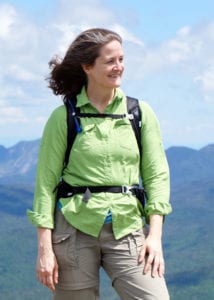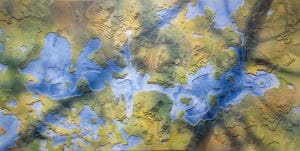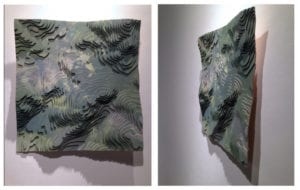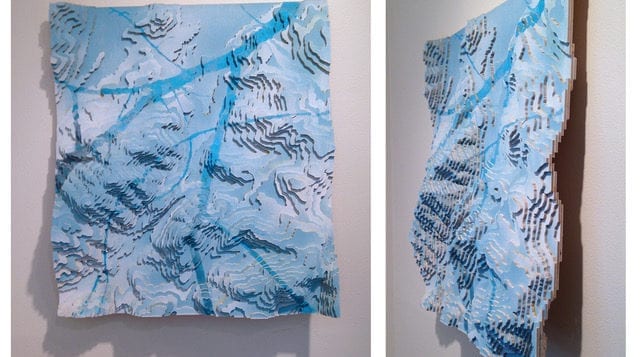By Irene Ruddock
Winn Rea addresses environmental themes in her sculptures, installations, videos and works on paper. She has exhibited in galleries and museums, both nationally and internationally, being awarded many prestigious grants and awards. Presently, her work is being shown at the Heckscher Museum of Art in an exhibit aptly titled Earth Muse: Art and the Environment. I recently had the opportunity to speak with Rea about her latest venture.

The exhibit at the Heckscher describes its exhibit as ‘presenting the work of artists who view the earth as muse for contemplation of nature’s beauty and diversity.’ Can you tell us what works you are showing there?
At the Heckscher Museum you can see examples of my topographic relief paintings. They are based on my time in the Adirondack Mountains. I love going to the Adirondacks because I can unplug from the wired world and reconnect with nature.
How does your time in nature translate into your artwork?
While hiking I “collect” shadows by photographing them. Back in the studio, I construct topographic reliefs based on U.S. Geological Survey maps of the area. They are built out of 1/8-inch Russian birch plywood that I paint using colors and shadow patterns from the woods. People are fascinated because the reliefs are not solid, they are hollow like sea shells, and the shadow almost fools you into looking over your shoulder for the tree that cast it.
What other ways do you use art to express your interest in the environment?
All of my works are a meditation on where I fit into the greater scheme of things on the planet. When I make videos, they are about the passage of time in the short term, like how the flow of water in a stream changes over the course of a day, or the long term — as in geologic time — which is explored in my works on paper that are made by evaporation.
In your works on paper, you say that you do not paint in the traditional sense, but tend to them as you would a garden. Can you explain what you mean by that?
Well, it helps to know my process for the works on paper: first, I sculpt the paper, crinkling it into folds like mountain ranges. Then I flood the paper with pigment, which slowly evaporates leaving marks much like contour lines. So, in effect, instead of pushing pigments here or there with a brush, I work in synchrony with the natural process of evaporation. In gardening terms, I prepare the “soil” (sculpted paper), “water it” (pour pigments), and “harvest” the result — a three-dimensional painting on paper.

You are an associate professor of art at Long Island University C.W. Post. What do you wish to get across to your students about how art and the environment are related?
I want to give students confidence in their own creativity and help them cultivate their problem-solving skills through the design process. The reality is, their capacity to imagine and realize new, sustainable ways to thrive is the answer to our planet’s future.
In your world exhibitions, is there one country that you enjoyed the most?
I most enjoyed my travels to Korea especially to the tea farms in the mountains. Here the tea bushes are planted along contour lines that accentuate the form of the mountains. I felt most at home there.
Many artists are looking for longevity in their work, yet you describe much of your work as ‘temporal.’ Why?
I want people to enjoy my work and even collect it in order to have it in their lives, if it brings pleasure to them. But I am not interested in making a commodity. I want my legacy to be longer lasting in terms of the way my work helps people to think about the world differently and to become more aware of the impact of their everyday choices on the planet.

‘Falling Water’ appears to be one of your most influential and popular installation sculptures. What effect were you trying to achieve?
In “Falling Water,” I made use of the sculptural and material qualities of our ubiquitous disposable water bottles. Cutting them on a curve releases the energy of a spiral. The clear plastic refracts the light, de-materializing the plastic. In a way, their beauty seduces us into ignoring their treachery — the needless use of petroleum products to package and transport a resource that we have as close as our tap.
What are you working on now?
I am working on a series of small topographic reliefs that include bodies of water. I am curious about bathometry (contours of the earth under water) and am exploring that margin between land and sea.
Do you have another exhibit coming up?
Yes, I have works hanging at Gallery 46 in Lake Placid. As part of the visual arts extension of the Lake Placid Center for the Arts, it is a great location for people to see my work in the context of the land that inspires it.
Can you tell us about your philosophy of life that influences your art?
The philosophy behind my work can be traced back to time spent hiking with my dad as a young girl. I loved the smell of the decaying leaves and movement of air amongst the trees. (I think of it now as the woods breathing.) My dad taught me to read the contours of the land while on the trail; back home he showed me where we had hiked on a 3-D topographic map. My dad also taught me about the natural cycle of things, of how the decay of one body feeds the life of another. This informs all my life’s work!
Winn Rea’s work is on exhibit at the Heckscher Museum of Art, 2 Prime Ave., Huntington through July 30. For more information, visit her website at www.winnrea.com.





